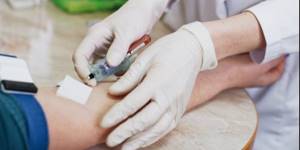Finding the cause of an allergy is very difficult. Very often, the body’s specific reaction to an irritant is mistaken for intestinal, skin or bronchopulmonary diseases. In order to identify the source of the problem, many tests have to be carried out.
A blood test for allergens is considered the most accurate of all methods that examine a patient's allergic status. During an allergic reaction, specific changes occur in the blood, which can be monitored using equipment.
Allergy diagnosis
An allergy is an unusual sensitivity to various substances that do not cause painful reactions in most people. As a rule, house dust, plant pollen, mold, epithelium of domestic animals, some types of food products, etc. become enemies. These agents become allergens and an allergy occurs.
The diagnosis of “allergy” does not sound scary. However, the consequences of this disease can be very serious. Therefore, at the first symptoms, be sure to consult a doctor.
Indications for analysis
The doctor prescribes this type of study if the following pathologies are suspected:
- hay fever;
- pneumonia;
- allergic reaction to medications;
- bronchial asthma;
- atopic dermatitis;
- allergic rhinitis and sinusitis;
- food allergy.
Skin tests may be performed in parallel with the blood test. The analysis is carried out not only when one of the forms of allergies is identified, but also when there is a burdened hereditary allergic history.
Another reason for taking blood is the suspicion of the presence of worms in the body.
Skin prick tests

The essence of the test is that scratches are made on pre-treated leather. Samples containing various allergens are applied to the scratch areas.
For one test you can put up to 15 samples, no more.
The test results are determined by the skin reaction - redness or swelling. This process usually takes 20-30 minutes. The speed of reaction to various allergens is different for everyone and manifests itself individually.
Sometimes, skin testing is not a suitable option for allergy testing. This happens due to some restrictions:
- Before the test (several days before) you should not take antiallergic and some other drugs; not every person can afford this
- It is not recommended to use this method for women in the first days of the menstrual cycle due to changes in hormonal levels.
And in some cases, skin allergy tests are not performed at all:
- If the patient has a period of exacerbation of allergies
- If the patient is sick with an acute infectious disease
- If a woman is pregnant or lactating
- If the patient is over 60 years old
- If the patient is under 3 years old
- Determination of allergens by blood (determination of specific immunoglobulins E)
How to prepare to donate blood
A blood test for allergens is performed during the period of remission on an empty stomach. This is required to ensure that the IgE level is as close to normal as possible. The patient is advised, if possible, to stop taking any medications, including antihistamines. However, such a restriction is introduced only at the request of a doctor. It is not advisable to take allergy tests in acute health conditions (fever, viral infections, gastrointestinal diseases in the acute stage, etc.). Immediately 3-5 days before the test, all highly allergenic foods should be excluded from the diet. Avoid contact with animals whenever possible. You should refrain from smoking 2 hours before the test.
Blood test for allergens (determination of specific immunoglobulins E)
Taking blood is one of the popular methods for determining allergens in the human body. It is preferred due to the lack of direct contact with allergens, which eliminates all possible risks.

Determination of specific immunoglobulins E (IgE) in the patient’s blood makes it possible to identify causally significant allergens. In modern laboratory conditions, it is possible to accurately identify a substance that provokes the immune system to an unusual reaction. In other words, identify the allergen.
Modern technologies make it possible to determine the level of specific antibodies that are responsible for the development of allergies. One of these innovations is the ImmunoCAP technique (ImmunoCAP analysis). Its peculiarity is that even in a small amount of blood IgE antibodies can be accurately detected, even in very low concentrations. Thanks to ImmunoCAP, you can confirm or exclude the diagnosis of allergy, prescribe appropriate therapy for a specific situation, and make a prognosis for the development of the disease.
The list of allergens is very wide. Remember that before conducting the examination, it is advisable to consult with your doctor to select the optimal panel.
What is specific immunoglobulin
Specific immunoglobulin, or IgE, is an antibody involved in the development of allergies. They are present in human tissues that come into contact with the external environment - skin, tonsils, adenoids, respiratory tract, gastrointestinal tract. Present in the bloodstream in small quantities. When IgE molecules combine with antigens, an immediate hypersensitivity reaction develops. An analysis for immunoglobulins allows you to determine their quantitative content in the blood and, based on the data obtained, draw a conclusion about your predisposition to allergies.
Features of testing for allergies in children
A child's body is very different from an adult's, so allergy tests may differ.
- An allergy test in a child under 3 years of age is not carried out on the skin, since allergens in children can only be detected in a blood test.
- For babies under one year old, testing for total immunoglobulin E is ineffective, since their immunity is still developing.
- Most often, children are prescribed a pediatric panel, which includes exactly those allergens that the child most often encounters (milk, pet hair, eggs, etc.)
The range of possible allergens has expanded greatly in recent years. Today it is not only food and insect bites, but also household chemicals, care cosmetics, and exhaust fumes.
In order to prevent danger and protect your child from the negative effects of allergens, you can conduct an allergy test. At the SKLIF medical center, professional allergists and immunologists will help you do this, and our nurses know how to take blood from even the smallest children.
Screening tests
For mixed allergies and other complex cases, a comprehensive analysis is required - a screening method using panels of food and inhalation allergens (from 50 to several hundred items). This is a fast and fairly economical technology that allows not only to compile a list of substances to which the body exhibits an increased response, but also illustrates their combined effects. In some cases, screening tests are performed with a large number of individual allergens. To save costs, a rapid screening with 12 food substances or 12 inhalant substances, or an extended level 1, 2 or 3 test can be performed.
What the analysis can show
Total Ig E levels vary depending on a person's age. However, even its normal level according to reference values does not completely exclude allergies. This is possible when reacting to a small amount of substances.
For example, there are known cases of allergies just to birch pollen. To combat pollen, Ig E increases, but the sum of all immunoglobulins of group E does not change significantly. As a result, the analysis indicates the presence of Ig E within the reference values.
Where can I get tested for allergens?
Where to take allergy tests and blood tests for allergies in Sochi? If you cannot determine the cause of the allergy, we recommend making an appointment with a doctor and getting tested. At the medical diagnostic center, you can take a general blood test, a blood test for immunoglobulin, and undergo examinations using allergy tests or an allergy panel. The laboratory has developed special allergy complexes, which include 11 allergens characteristic of Sochi, the cost of the complex is 1500 RUR. Test results will be ready the next day. It is also possible to conduct allergy tests - the body’s reaction will follow within 15-20 minutes.
Do not forget that the first step to treating allergies begins with examination and search for the causative agent of the body’s atypical reaction. Only after this is it possible to prescribe treatment that will help reduce allergic manifestations to a minimum.
Specific IgG
In recent years, the attention of allergists has been attracted by IgE-independent food allergies, the immunopathogenesis of which is associated with the production of various subclasses of IgG antibodies involved in immunopathological reactions with chronic inflammatory diseases and “latent” forms of food allergies. To diagnose hidden food allergies, quantitative determination of IgG subclasses of specific antibodies (IgG1-IgG4) to individual food antigens is used. As with the interpretation of the results of detecting general and specific IgE, the conclusion should be made by an allergist taking into account the anamnesis and clinical picture of the disease.
How is the analysis carried out?
In practice, an allergen test is preceded by a general blood test. When studying it, the doctor pays attention to the number of eosinophils. If there are many of them, an allergen test is prescribed.
General IgG or immunoglobulin analysis. To conduct the study, a reagent is added to the serum, and then the material is examined under a microscope.
Screening for various allergens, which is carried out using the flow cytometry method. In this type of research, cells are examined individually in a fluid flow using fluorochromes under better light.
How does an allergy occur?
Allergies are hereditary. If one parent suffers from an allergy, the child has a 30-40% chance of developing it. If both parents are sick, then this probability increases to 70-80%. However, it is important to understand that it is not the disease itself that is inherited, but the predisposition to it.
Various factors can trigger an allergic reaction. At the same time, in response to the re-entry of the allergen into the body, a strong reaction of the immune system occurs, which is accompanied by the destruction of mast cells and basophils with the release of various substances, the main of which is histamine. It is he who starts the process of inflammation.
Allergens include inhalation, food, household, insect, fungal, pollen, and epidermal allergens. Some of them, such as inhaled allergens (pollen from plants, trees, fungal spores), are especially common in the spring and summer. In the warm season, there is also a danger of encountering insects (wasps, bees, ticks), in response to whose bites severe allergic reactions occur.
History includes
- Family history (family anamnesis) - information about illnesses of relatives
- Symptoms of your disease and conditions of their occurrence (where and when)
- Your home habits
- Activities at work and at leisure
- Microenvironment (house, city district)
- Food cravings
- Your general health (have you been treated for anything, taken any medications, etc.)
In addition to the interview, the doctor has several accurate and objective methods to confirm the diagnosis.
Skin tests
This is one of the most informative diagnostic tests for allergies. It is the introduction into the skin (forearm or back) of small quantities of purified allergens in a certain concentration.
There are several methods for conducting such tests:
- Scarification test - the doctor performs superficial scratching (scarification) of the upper layer of skin with the introduction of an allergen into this area
- Intradermal test - the allergen is injected with a syringe with a very thin needle
- Needle test (prick test) - a drop of allergen is applied to the skin, and then a thin puncture of the skin with a needle is made under this drop
Allergens are used in skin tests in various dilutions. In all three cases, the results of the reaction can be assessed after 20 minutes. The test is considered positive if the formation of a papule (dense nodule on the skin), erythema (redness) or rash is noted.
Blood analysis
To diagnose allergies, determining the concentration of immunoglobulin E (IgE) in the blood is of great importance. An increase in its content indicates the body’s production of specific antibodies against environmental allergens. Determination of IgE is carried out in blood serum from a vein. The method is based on the use of a mixture of purified allergens, in the presence of which IgE class antibodies bind to them and form antigen (allergen)-antibody complexes. Both general and allergen-specific IgE are determined. Sensitivity can be determined to more than 200 allergens, but the doctor will select specific ones that are necessary to make a diagnosis.
The peculiarity of this method is that the patient does not need to come into direct contact with the allergen, and the risk caused by this is eliminated.
Currently, a blood test for specific IgE is usually used for the following categories of patients:
- If the patient is afraid of the skin test
- If there is a risk of a severe reaction to the skin test
- If the patient is taking antihistamines and certain other medications that may affect the accuracy of the skin test
- If the patient has serious skin problems
- If the patient is a child under three years old
Provocative tests
The principle of these tests is to reproduce the symptoms of an allergic reaction through contact with an allergen. If a reaction develops in response to the introduction of a suspected allergen, then the allergen can be considered causally significant (specific).
To provoke, for example, an exacerbation of bronchial asthma, physical activity, cold, etc. are used, or the patient is inhaled in turn with possible allergens (provocative inhalation test). A similar principle is also used to induce allergic rhinitis (nasal challenge test) or food allergies (oral challenge test).
Provocative tests are used only when there are discrepancies between the medical history, the results of skin tests and biochemical studies (IgE, etc.). Such tests are carried out in specialized centers, since the interpretation of the data obtained requires special knowledge and the tests can aggravate the patient’s condition.
Provocative tests are also used to determine the severity of allergies and determine the effectiveness of drug therapy.
What does the result say?
The analysis showed a high level of total Ig E, and there was an allergy with symptoms. But it is impossible to find a causally significant allergen. This is due to the fact that most people with allergies have reactions to several groups of allergens at once. They react to a certain food product if there is a history of reaction to pollen from flowering plants.
For example, a patient with an allergy to birch pollen will also show symptoms to plant foods with a similar protein structure. The reaction will manifest itself on apples, peaches, kiwi, peanuts and hazelnuts. At the same time, having passed the food panel, the result will not show an allergy to the specified food products, although the symptoms are obvious. And the reason lies in the very essence of the allergy - its cross-reaction during the production of special Ig E to birch pollen proteins.
What is screening and inhalation panel?
In some cases, if a food or inhalation allergic reaction occurs, it is necessary to identify the allergen in order to protect the patient from contact with it. For such diagnostics, so-called “panels” are used. The most commonly used:
- Inhalation panel of 12 allergens (pollen of cereals, birch, ragweed, wormwood, dandelion, mold, mites, house dust, cockroach, cat dander, dog dander, feather);
- Food panel of 12 allergens: milk, egg, fish, shrimp, nuts, grains, soy, beans, carrots, orange, strawberry, tomato;
- In addition, an extended screening test is carried out in three versions with 50, 70 and 100 allergens.
It is screening that helps to find out that the patient, for example, is allergic to cats, because particles of the epidermis (skin) of animals are a common allergen. In addition, this method can be used to conduct research in case of allergies to medications. This is much safer than the usual intradermal test.
Reasons for false results
The reason for incorrect diagnosis may be taking blood for analysis from a patient during an illness caused by an infection. In this case, the appearance of specific formations was provoked by the presence of microbes and viruses. The allergen test can be repeated only after a week from the onset of the disease. On average, a common cold will end by this time.
The result of the study is influenced by radiation and chemotherapy; in this case, the number of immunoglobulins is reduced.
The test result may be affected by taking certain types of medications:
- aminophenazone;
- anticonvulsants;
- asparaginase;
- hydralazine;
- hydantoin derivatives;
- oral contraceptives;
- phenylbutazone.
All these drugs increase the content of immunoglobulins when taken.
Like really
The first test that needs to be performed is an indicator of the presence of immunoglobulin in the blood.
Why he? Immunoglobulins are specific proteins in the human body. Their task is to fight alien agents. Immunoglobulins of different classes are produced to fight either viruses or bacteria. Thus, immunoglobulin E is important in resisting parasites (helminths and protozoa), as well as in the development of bronchial asthma, allergic rhinitis, neurodermatitis and urticaria. Analysis for its presence can give an accurate and informative answer. On the basis of which the doctor selects and carries out ASIT (allergy-specific immunotherapy) and helps to cure the person.
Preparation for the procedure
- The material is collected on an empty stomach, in the morning.
- When preparing for analysis, you must avoid strong coffee and tea.
- The day before and on the day of the examination, the consumption of alcohol and energy drinks is prohibited.
- Eating is not advisable within eight hours before blood sampling.
- The day before the examination, you should not eat food containing large amounts of fats and carbohydrates.
If the preparation rules are not followed, there is a high risk of obtaining a false research result.







